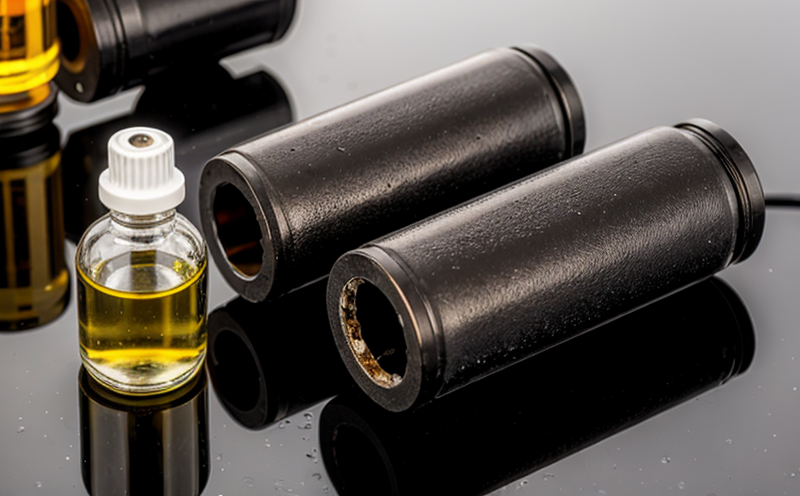EPA 1664 Oil and Grease Partition Gravimetric Test in Water
The EPA 1664 oil and grease partition gravimetric test is a crucial method for assessing the quality of water samples, particularly focusing on oil and grease content. This test is widely used to monitor industrial discharges into wastewater systems as well as surface waters, ensuring that environmental regulations are met.
The primary objective of this test is to measure the total amount of non-water components in a given sample, which includes both floating oils and emulsified oils along with grease. The methodology involves partitioning these substances between two phases: an organic layer and an aqueous phase. Once separated, the oil and grease are extracted from each phase individually before being weighed.
The test protocol is stringent and requires precise handling of samples to ensure accurate results. It begins by taking a representative water sample which must be free from any external contamination sources. After collection, the sample undergoes initial conditioning steps such as pH adjustment or temperature control if necessary. Then comes the critical step where the sample is divided into two parts; one part remains in its original aqueous state while the other is transferred to an organic solvent (such as hexane) for extraction.
The partitioning process ensures that all oil and grease present within both phases can be effectively separated out. Once this separation has been achieved, each fraction undergoes further treatment where the water content is evaporated away leaving behind only pure oil or grease residues. These residues are then dried thoroughly in an oven set at specific temperatures before being weighed to calculate their respective masses.
The accuracy and precision of results obtained from EPA 1664 tests play a vital role not just for regulatory compliance but also in understanding the overall health condition of aquatic ecosystems affected by pollutants like oil or grease. By providing reliable data about pollutant levels, these tests help identify sources of contamination and guide appropriate remediation efforts.
It's important to note that proper sample preparation is key to achieving accurate results. Any deviation from standard procedures could lead to erroneous conclusions regarding the actual contaminant levels in a water body. Therefore, it’s advisable for laboratories performing such analyses to adhere strictly to all outlined steps laid out in Method 1664.
In conclusion, the EPA 1664 oil and grease partition gravimetric test serves as an essential tool in environmental monitoring programs aimed at protecting our natural resources from harmful pollutants. Its rigorous nature ensures that only accurate measurements are made available for decision-makers responsible for safeguarding public health and preserving ecological balance.
Why It Matters
The significance of the EPA 1664 oil and grease partition gravimetric test extends beyond mere compliance; it provides valuable insights into the state of our water bodies. By measuring the concentration of oil and grease, this test helps identify potential sources of pollution such as industrial runoff or accidental spills during transportation.
For quality managers and compliance officers, accurate measurement through EPA 1664 ensures that their facilities are in full adherence with environmental regulations set forth by governing bodies like the U.S. Environmental Protection Agency (EPA). This not only prevents costly fines but also protects reputation among stakeholders who expect responsible stewardship of resources.
R&D engineers benefit greatly from this data as they use it to develop better purification technologies and treatment methods for contaminated waters. Understanding where pollutants originate can lead to targeted solutions that address specific issues more effectively than broad approaches.
Procurement departments also stand to gain by leveraging information derived from EPA 1664 tests when selecting suppliers whose practices align with sustainable practices. Knowing the integrity of raw materials sourced directly impacts product quality and safety downstream throughout supply chains.
In summary, the importance of implementing rigorous testing procedures like those stipulated in Method 1664 cannot be overstated given its direct implications for maintaining ecological balance while simultaneously supporting economic growth through informed decision-making processes across various sectors involved in water resource management.
Customer Impact and Satisfaction
Clients seeking reliable data on oil and grease content in their water samples can rest assured knowing that our laboratory adheres strictly to EPA 1664 guidelines. Our commitment to providing precise measurements fosters trust among customers, ensuring they receive accurate information which is critical for making informed decisions.
Quality managers appreciate the consistent results we deliver because these allow them to monitor trends over time effectively. This helps in identifying early signs of potential problems before they escalate into larger issues requiring extensive corrective measures.
Compliance officers find comfort knowing that our rigorous testing process meets or exceeds all required standards, thereby reducing their administrative burdens associated with proving regulatory compliance.
R&D engineers trust the data produced by our lab as it serves as a reliable foundation for developing innovative solutions aimed at mitigating environmental impacts caused by pollutant discharges into water systems. Their confidence in us translates to longer-term partnerships built on mutual respect and shared goals towards sustainability objectives.
Our focus on delivering high-quality results has earned us excellent ratings from satisfied customers across different industries. By consistently meeting expectations set forth by EPA 1664, we have established ourselves as leaders in the field of water testing services.
International Acceptance and Recognition
- EPA Method 1664 is recognized globally for its reliability and consistency. Many countries adopt similar methods based on this standard to ensure uniformity across borders.
- The test has been endorsed by organizations such as the International Organization for Standardization (ISO), providing further validation of its robustness and applicability worldwide.
- Regulatory bodies in Europe also refer to EPA 1664 when developing their own guidelines, ensuring that European standards are aligned with international best practices.
The widespread acceptance of this method underscores its importance as a cornerstone tool for environmental monitoring. Its global recognition ensures that data generated using this technique can be compared across different regions confidently.





